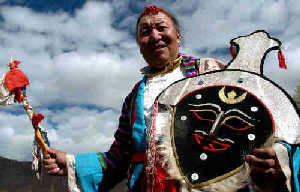However, Tibetan Opera, boasting the longest history among the few other folk operas of Chinese ethnic minorities, was once on the verge of fading away in the 20th century like many other traditional folk arts.
During the 600-year of development, Tibetan people created about 20 traditional repertoires, but unfortunately some of the play scripts have been lost, and only the names, and sometimes the plots, are remembered today. Some village troupes are unable to play the famous Eight Great Classical Tibetan Operas, and other troupes were even disbanded years ago because of the passing away of elder artists, a drain of excellent performers, capital shortage, and the influence of "pop dances and songs," all of which resulted in an accelerated phasing-out of Tibetan Opera.
To salvage and preserve the threatened unique Tibetan art, a nationwide rescue program has been launched in recent years, and the local government of Tibet is busy preparing for Tibetan Opera to be listed as a "Masterpiece of Oral and Intangible Heritage of Humanity" by UNESCO (United Nations' Educational, Scientific and Cultural Organization).
Today, Tibetan Opera is becoming increasingly recognized in other parts of China and beyond; it has toured Japan, the United States, and other countries, where it is regarded as a treasure of Chinese ethnic art.
 The Story ofKing GesarEpic
The Story ofKing GesarEpic
 The Story of King Gesar was transmitted in the form ofquyiin Tibet, Qinghai, Sichuan, and Gansu, where most Tibetan communities have been traditionally located. Originally it was a lengthy epic poem about a Tibetan national hero, and its adaptation to the quyi form helped to root it deeply in the Tibetan community, where it was handed down orally from generation to generation.
The Story of King Gesar was transmitted in the form ofquyiin Tibet, Qinghai, Sichuan, and Gansu, where most Tibetan communities have been traditionally located. Originally it was a lengthy epic poem about a Tibetan national hero, and its adaptation to the quyi form helped to root it deeply in the Tibetan community, where it was handed down orally from generation to generation.
The Story of King Gesar epic has a rich diversity of expressions: singing, dialogue, explanations by means of illustrations, and so on. When it is sung in the Tibetan language, a lute made of a cow horn accompanies it. Since the epic is rich in content, its structure and musical composition are rich or bulky in nature. Normally, traveling minstrels who are responsible for recounting the history of the Tibetan people sing only certain episodes from the epic.
The Story of King Gesar dates back as far as the 7th century BC. It attained its present form in the 9th century. There are as many as 100 volumes of the biography, containing 1,700,000 lines of script.
Gesar was the son of the God of Heaven. He was incarnated into the family of a rich and powerful headman to right the injustices in the secular world. Gesar was an excellent horseman and skilled at martial arts. He became king after winning a horse race. He led his people to conquer evil and drive away demons. In his campaigns across the land he helped the poor and weak, and safeguarded the interests of the Tibetan ethnic group. He was highly respected and won great honor among the Tibetan people.
The performers of the epic fall into three categories: The hazhong is said to have inherited the art from previous generations of storytellers; the niagxia sing and tell stories concerning King Gesar that are largely created by them; and the baozhong are said to have been taught the stories by a divine being while in a trance.
Leading singing andstorytellingartists specializing in the King Gesar epic have appeared in modern times, such as Zaba of the Tibetan ethnic group and Pajie of the Mongolian ethnic group. Other Tibetan singers who are held in great esteem include Cairang Wangdui, Sangzhu, and Yumei in Mongolia. Luobusang is the foremost such artist. These men are regarded as national treasures since they are the guardians of an ancient oral tradition.
